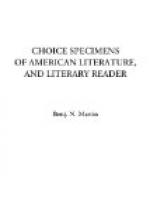* * * * *
=_Brantz Mayer, 1809-._= (Manual, p. 490.)
From “Mexico, Aztec,” &c.
=_136._= REKINDLING THE SACRED FIRE.
At the end of the Aztec or Toltec cycle of fifty-two years,—for it is not accurately ascertained to which of the tribes the astronomical science of Tenochtitlan is to be attributed,—these primitive children of the New World believed that the world was in danger of instant destruction. Accordingly, its termination became one of their most serious and awful epochs, and they anxiously awaited the moment when the sun would be blotted out from the heavens, and the globe itself resolved once more into chaos. As the cycle ended in the winter, the season of the year, with its drearier sky and colder air, in the lofty regions of the valley, added to the gloom that fell upon the hearts of the people. On the last day of the fifty-two years, all the fires in temples and dwellings were extinguished, and the natives devoted themselves to fasting and prayer. They destroyed alike their valuable and worthless wares; rent their garments, put out their lights, and hid themselves for awhile in solitude....
At dark on the last dread evening,—as soon as the sun had set, as they imagined, forever,—a sad and solemn procession of priests and people marched forth from the city to a neighboring hill, to rekindle the “New Fire.” This mournful march was called “the procession of the gods,” and was supposed to be their final departure from their temples and altars.
As soon as the melancholy array reached the summit of the hill, it reposed in fearful anxiety until the Pleiades reached the zenith in the sky, whereupon the priests immediately began the sacrifice of a human victim, whose breast was covered with a wooden shield, which the chief flamen kindled by friction. When the sufferer received the fatal stab from the sacrificial knife of obsidian, the machine was set in motion on his bosom until the blaze had kindled. The anxious crowd stood round with fear and trembling.




